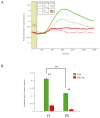Difference in visual processing assessed by eye vergence movements
- PMID: 24069140
- PMCID: PMC3777953
- DOI: 10.1371/journal.pone.0072041
Difference in visual processing assessed by eye vergence movements
Abstract
Orienting visual attention is closely linked to the oculomotor system. For example, a shift of attention is usually followed by a saccadic eye movement and can be revealed by micro saccades. Recently we reported a novel role of another type of eye movement, namely eye vergence, in orienting visual attention. Shifts in visuospatial attention are characterized by the response modulation to a selected target. However, unlike (micro-) saccades, eye vergence movements do not carry spatial information (except for depth) and are thus not specific to a particular visual location. To further understand the role of eye vergence in visual attention, we tested subjects with different perceptual styles. Perceptual style refers to the characteristic way individuals perceive environmental stimuli, and is characterized by a spatial difference (local vs. global) in perceptual processing. We tested field independent (local; FI) and field dependent (global; FD) observers in a cue/no-cue task and a matching task. We found that FI observers responded faster and had stronger modulation in eye vergence in both tasks than FD subjects. The results may suggest that eye vergence modulation may relate to the trade-off between the size of spatial region covered by attention and the processing efficiency of sensory information. Alternatively, vergence modulation may have a role in the switch in cortical state to prepare the visual system for new incoming sensory information. In conclusion, vergence eye movements may be added to the growing list of functions of fixational eye movements in visual perception. However, further studies are needed to elucidate its role.
Conflict of interest statement
Figures





Similar articles
-
A role of eye vergence in covert attention.PLoS One. 2013;8(1):e52955. doi: 10.1371/journal.pone.0052955. Epub 2013 Jan 31. PLoS One. 2013. PMID: 23382827 Free PMC article.
-
Eye vergence responses during a visual memory task.Neuroreport. 2017 Feb 8;28(3):123-127. doi: 10.1097/WNR.0000000000000734. Neuroreport. 2017. PMID: 28121809
-
Attentional Selection Accompanied by Eye Vergence as Revealed by Event-Related Brain Potentials.PLoS One. 2016 Dec 14;11(12):e0167646. doi: 10.1371/journal.pone.0167646. eCollection 2016. PLoS One. 2016. PMID: 27973591 Free PMC article.
-
The neural control of fast vs. slow vergence eye movements.Eur J Neurosci. 2011 Jun;33(11):2147-54. doi: 10.1111/j.1460-9568.2011.07692.x. Eur J Neurosci. 2011. PMID: 21645108 Review.
-
A physiological perspective on fixational eye movements.Vision Res. 2016 Jan;118:31-47. doi: 10.1016/j.visres.2014.12.006. Epub 2014 Dec 20. Vision Res. 2016. PMID: 25536465 Free PMC article. Review.
Cited by
-
Fostering the Aesthetic Pleasure: The Effect of Verbal Description on Aesthetic Appreciation of Ambiguous and Unambiguous Artworks.Behav Sci (Basel). 2021 Oct 23;11(11):144. doi: 10.3390/bs11110144. Behav Sci (Basel). 2021. PMID: 34821605 Free PMC article.
-
A validation study on the accuracy and precision of gaze and vergence using stereoscopic eye-tracking technology.Behav Res Methods. 2025 Jul 1;57(8):214. doi: 10.3758/s13428-025-02731-1. Behav Res Methods. 2025. PMID: 40593383 Free PMC article.
-
Neurophysiological indicators of internal attention: An electroencephalography-eye-tracking coregistration study.Brain Behav. 2020 Oct;10(10):e01790. doi: 10.1002/brb3.1790. Epub 2020 Aug 20. Brain Behav. 2020. PMID: 32816400 Free PMC article.
-
Effect of visual attention and horizontal vergence in three-dimensional space on occurrence of optokinetic nystagmus.J Eye Mov Res. 2019 Feb 28;12(1):10.16910/jemr.12.1.2. doi: 10.16910/jemr.12.1.2. J Eye Mov Res. 2019. PMID: 33828722 Free PMC article.
-
Eye vergence responses to novel and familiar stimuli in young children.Acta Psychol (Amst). 2019 Feb;193:190-196. doi: 10.1016/j.actpsy.2019.01.007. Epub 2019 Jan 15. Acta Psychol (Amst). 2019. PMID: 30654274 Free PMC article.
References
-
- Awh E, Armstrong KM, Moore T (2006) Visual and oculomotor selection: links, causes and implications for spatial attention. Trends Cogn Sci 10: 124-130. doi:10.1016/j.tics.2006.01.001. PubMed: 16469523. - DOI - PubMed
-
- Hafed ZM, Clark JJ (2002) Microsaccades as an overt measure of covert attention shifts. Vision Res 42: 2533-2545. doi:10.1016/S0042-6989(02)00263-8. PubMed: 12445847. - DOI - PubMed
-
- Engbert R, Kliegl R (2003) Microsaccades uncover the orientation of covert attention. Vision Res 43: 1035-1045. doi:10.1016/S0042-6989(03)00084-1. PubMed: 12676246. - DOI - PubMed
-
- Martinez-Conde S, Macknik SL, Troncoso XG, Dyar TA (2006) Microsaccades counteract visual fading during fixation. Neuron 49: 297-305. doi:10.1016/j.neuron.2005.11.033. PubMed: 16423702. - DOI - PubMed
Publication types
MeSH terms
LinkOut - more resources
Full Text Sources
Other Literature Sources
Medical

